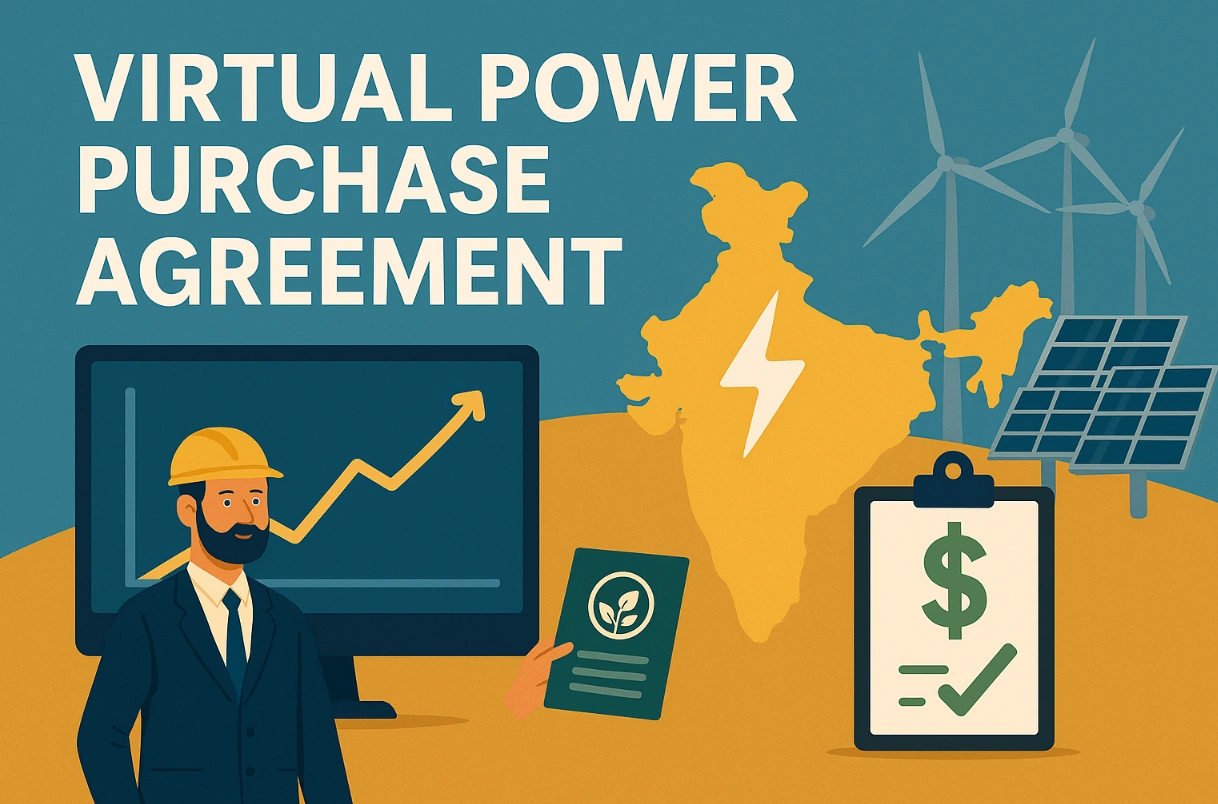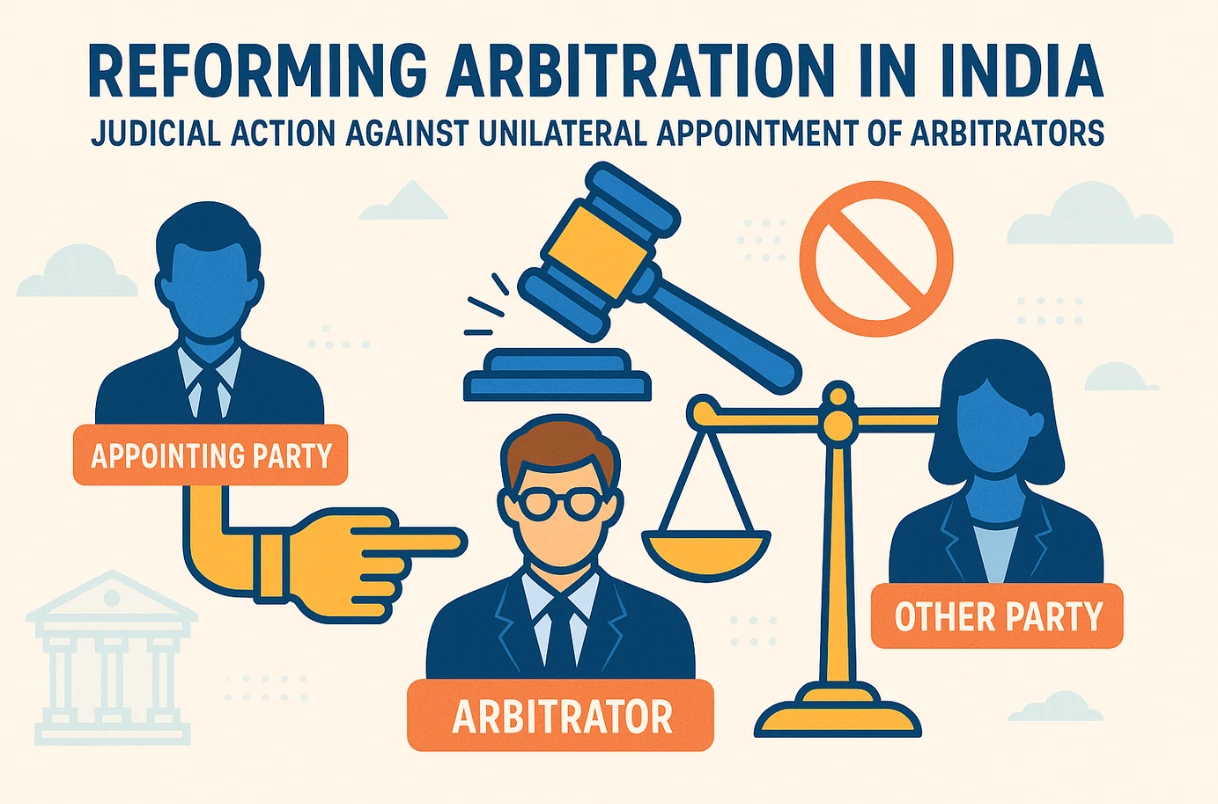VPPA in India: Benefits, Process & Key Guidelines

By – Devank Maheshwari and Tannishtha Chatterjee
Table of Contents
Introduction: What Is a Virtual Power Purchase Agreement (VPPA)?
A Virtual Power Purchase Agreement (VPPA) is a financial contract between a renewable energy generator and a buyer, designed to support clean energy procurement without involving the physical delivery of electricity. Unlike a traditional Power Purchase Agreement (PPA), where electricity is directly/physically supplied to the buyer, a VPPA allows the generator to sell its electricity on the wholesale power market while transferring the environmental benefits, such as Renewable Energy Certificates (RECs), to the buyer.
At its core, a VPPA acts as a financial hedge against electricity price fluctuations. The parties agree on a fixed “strike price” for a notional amount of electricity. If the market price rises above this strike price, the generator pays the difference to the buyer; if the market price falls below it, the buyer compensates the generator. This arrangement, often structured as a “contract for differences,” provides price stability for both sides while enabling the buyer to claim the renewable attributes of the project.
A VPPA combines the financial benefits of price certainty with the environmental benefits of supporting renewable energy procurement, making it a widely used tool for corporations and institutions seeking to meet sustainability goals.
Why VPPAs Matter: Benefits for Buyers, Developers, and Utilities
VPPAs have become an important tool for companies and renewable energy developers to work together on clean energy goals.
For Corporate Buyers
For corporate buyers, a VPPA helps meet decarbonization and sustainability commitments by allowing them to buy the environmental benefits of renewable energy (usually through RECs) without physically taking the power. This means they can keep buying electricity from their local utility while still claiming the green energy benefits.
VPPAs also let companies pool the energy needs of facilities in different locations, making it easier to achieve 100% renewable energy targets.
For Renewable Energy Developers
For renewable energy developers, a VPPA provides a stable, long-term price for their electricity, reducing exposure to market price swings.
This financial stability makes projects more attractive to investors and improves access to green financing.
For Utilities (DISCOMs)
For utilities (DISCOMs), VPPAs do not disrupt their existing relationship with customers, since no actual power is transferred between the generator and the buyer. They also help avoid technical challenges like grid congestion that often come with large amounts of renewable energy.
CERC’s Draft Guidelines for VPPAs: A Step Toward Formalization
Background: SEBI vs. CERC on Electricity Derivatives
To resolve the long-standing jurisdictional overlap between the Central Electricity Regulatory Commission (CERC) and the Securities and Exchange Board of India (SEBI) regarding regulation of “electricity derivatives,” the Ministry of Power (MoP) constituted a Committee on Efficient Regulation of Electricity Derivatives on October 26, 2018. The Committee included representatives from CEA, CERC, POSOCO, SEBI, and various power exchanges.
The Committee submitted its report on 30.10.2019, recommending, among other things:
- All “Ready Delivery Contracts and Non-Transferable Specific Delivery” (NTSD) contracts in electricity, executed by members of power exchanges, should fall under CERC’s jurisdiction, provided that:
- Contracts are settled only through physical delivery, with no netting allowed.
- Rights and liabilities of parties are non-transferable.
- No part of the contract bypasses the requirement for actual delivery or full payment.
- Circular trading and rollover of positions are prohibited.
- Only authorized grid-connected entities or trading licensees (on their behalf) may participate.
- Contracts may be annulled or curtailed due to technical or transmission constraints, but once annulled, they cannot be reopened or rolled over.
- All other electricity derivatives (i.e., those not classified as NTSD) would fall under SEBI’s regulatory ambit.
After this, the next step was to clarify the rules for VPPAs. On 31.01.2025, SEBI stated that VPPAs are over-the-counter (OTC) contracts that cannot be traded or transferred, the Securities Contracts (Regulation) Act would not apply to them if they were treated as Non-Transferable NTSD contracts, and that CERC would be the regulator for such agreements.
CERC, then, issued the Draft Guidelines for Virtual Power Purchase Agreements on 22.05.2025 (Draft Guidelines), marking a major step toward formalizing VPPA transactions in India. Under the Draft Guidelines, VPPAs are defined as NTSD based OTC contracts between a renewable energy (RE) generator and a consumer, where the generator sells electricity through the power exchange (DAM/RTM) or other modes permitted under the Electricity Act, 2003, transfers the resulting res to the consumer for Renewable Energy Consumption Obligation (RCO) compliance or claiming green attributes (with no trading of RECs allowed), and settles any difference between the mutually agreed VPPA price and the market price directly between the contracting parties.
Key Features of the Draft Guidelines
Some of the key features of the Draft Guidelines are:
1. Regulatory Status
VPPAs are classified as NTSD based OTC contracts. They are private agreements between a renewable energy generator and a consumer, which cannot be traded or transferred. SEBI has clarified that such contracts are outside the scope of the Securities Contracts (Regulation) Act, 1956, placing them under the jurisdiction of CERC.
2. Price Settlement
A VPPA is different from a traditional physical PPA, which involves actual delivery of electricity. Instead, a VPPA is a financial agreement that fixes a price for electricity to protect both parties from market price fluctuations. The generator sells its electricity in the market (through DAM, RTM, or other approved modes) at current market rates, and both parties agree on a fixed strike price in advance. If the market price is higher than the strike price, the generator pays the buyer the difference; if it is lower, the buyer pays the generator. This arrangement works as a Contract for Differences (CfD), where no physical delivery takes place, but payments are exchanged to balance out the price difference, helping manage market volatility.
3. Sale of Power and REC Transfer
The generator sells electricity in the market but transfers the RECs to the consumer. These RECs can be used for RCO compliance or to claim green energy benefits. They cannot be traded further.
4. Project Registration
Only projects registered under the CERC REC Regulations, 2022 can participate in VPPAs. This ensures that the RECs issued come from eligible and verified renewable energy projects.
5. REC Extinguishment
Once RECs are transferred to the consumer, the consumer must inform the REC registry, which will then cancel (extinguish) them. This prevents resale or double use of the same certificates.
6. Consumer Flexibility
Since VPPAs do not involve physical delivery of power, consumers can continue buying electricity from their local DISCOMs or other suppliers while still claiming renewable energy benefits from the VPPA.
7. Dispute Resolution
Any disputes under a VPPA are resolved based on the terms agreed between the parties, without CERC interference in contractual matters.
Jurisdictional Clarity: SEBI vs. CERC on VPPA Regulation
The Legal Dispute: Who Regulates Electricity Derivatives?
The jurisdictional dispute over VPPAs first emerged in Multi Commodity Exchange of India Limited & Anr. v. Central Electricity Regulatory Commission & Ors.1, where the SEBI contended that futures and forward contracts, such as derivative agreements like VPPAs, are purely financial contracts and should therefore fall under the jurisdiction of a specialised body created to regulate such instruments, rather than the CERC.
CERC, however, maintained that Section 66 read with Section 178(2)(y) of the Electricity Act empowered it to regulate the development of the electricity market, which should also encompass futures and forward trading in electricity.
Supreme Court Settlement in PXIL v. SEBI
This regulatory turf dispute was ultimately settled by the Hon’ble Supreme Court in Power Exchange of India Ltd. through Vice President v. Securities and Exchange Board of India & Ors.2 Following the Court’s decision, CERC and SEBI agreed that CERC would regulate physical delivery-based forward contracts, while SEBI would regulate financial and commodity derivatives in electricity.
The settlement delineated the following jurisdictional boundaries:
CERC’s jurisdiction
CERC would regulate all Ready Delivery Contracts and NTSD Contracts in electricity among power exchanges registered under the CERC (Power Market) Regulations, 2010, as defined under the Securities Contracts (Regulation) Act, 1956 (SCRA), subject to conditions:
- Settlement is solely through physical delivery without netting.
- Rights and liabilities under the contract cannot be transferred.
- No contract is fulfilled entirely or partially in a way that avoids actual delivery of electricity or full payment of price.
- Circular trading and rollover of positions are prohibited.
- Only authorised grid-connected entities or trading licensees acting for such entities may participate.
- Contracts may be annulled or curtailed for transmission or other technical limitations, but annulled contracts cannot be reopened or renewed.
- CERC must be provided with all trade-related information and will monitor contract performance.
SEBI’s jurisdiction
- SEBI would regulate:
- Commodity derivatives in electricity other than NTSD contracts.
- All contracts as defined in the SCRA, 1956.
How a VPPA Works: Financial Structure and Settlement
A VPPA is a financial contract between a RE generator and a commercial or industrial (C&I) consumer, without involving the physical delivery of electricity. In this arrangement, the RE generator sells the electricity it produces on power exchanges such as IEX or PXIL at prevailing market prices. The consumer, instead of receiving the actual electricity, obtains the renewable energy attributes (green energy credits) linked to that power, based on a pre-agreed contract price known as the strike price.
The settlement is purely financial: if the market price exceeds the strike price, the generator pays the consumer the difference; if the market price falls below the strike price, the consumer pays the generator the shortfall. This mechanism, called a CfD, ensures price stability for both parties while enabling the consumer to claim the environmental benefits through the transferred green credits.
Illustration: How a VPPA Functions in Practice
VPPA can be better understood through the example of SolarCo, a renewable energy generator operating a 100 MW solar plant, and TechMart, a large retail chain aiming to meet its sustainability goals. Both parties sign a VPPA for a fixed strike price of ₹4.00/kWh for a 10-year term. Importantly, no physical electricity flows from SolarCo to TechMart.
Under the agreement, SolarCo sells its generated electricity into the Indian Energy Exchange (IEX) at the prevailing market price. TechMart, in turn, receives the RECs associated with the traded electricity, which it can use to meet its green energy targets. The financial settlement is based on the difference between the strike price and the market price.
If, for example, the market price on a given day is ₹5.20/kWh, SolarCo pays TechMart the difference of ₹1.20/kWh for the contracted volume. Conversely, if the market price drops to ₹3.50/kWh, TechMart pays SolarCo ₹0.50/kWh. Through this arrangement, TechMart enjoys price stability and protection from market volatility, while SolarCo secures predictable revenues.
The VPPA, thus, enables both parties to promote renewable energy adoption without the complexities of physical power delivery.
Conclusion: VPPAs and the Future of Corporate Renewable Procurement
VPPAs are a practical way for companies to support renewable energy without directly receiving the electricity. Instead of changing their current power supply, companies pay a fixed price to a renewable energy project, and in return, they get RECs to show their commitment to clean energy. This helps them meet sustainability goals while giving renewable energy developers steady and predictable income to fund their projects.
With recent clarity from CERC and SEBI on who will regulate such contracts, India now has the base to make VPPAs a regular feature in the energy market. This clear framework ensures all parties, companies, generators, and regulators, work within defined rules. VPPAs can now play a big role in speeding up India’s shift to clean energy while also helping businesses meet their climate targets in a cost-effective and flexible way.
FAQs
-
What is a Virtual Power Purchase Agreement (VPPA)?
A Virtual Power Purchase Agreement (VPPA) is a financial contract – specifically a Non-Transferable Specific Delivery (NTSD) Over-the-Counter (OTC) agreement—between a renewable energy generator and a consumer or designated consumer. Under the VPPA, the generator sells power on the open market, while the consumer agrees to pay a pre-determined price (strike price) for the green attributes of that power over the contract period.
-
How does a VPPA work in India?
In a VPPA, the generator sells electricity on exchanges such as the Day Ahead Market (DAM) or Real-Time Market (RTM) at prevailing rates. The buyer does not receive the physical power but is financially settled based on the difference between the strike price and market price. Additionally, the renewable energy attributes (such as RECs) are transferred to the buyer, enabling them to meet sustainability or RPO targets without changing their physical power procurement.
-
What are the benefits of a VPPA for companies?
VPPAs allow companies to meet renewable energy and decarbonization goals without altering existing power supply arrangements. They offer financial stability through fixed pricing, facilitate REC acquisition for RPO compliance, and demonstrate ESG commitments. VPPAs also enable multi-site corporations to aggregate their energy needs into a single clean energy procurement strategy.
-
How is a VPPA different from a physical PPA?
A physical Power Purchase Agreement involves the direct supply and delivery of electricity to the buyer through the grid. In contrast, a VPPA is a financial contract where no physical delivery occurs. The electricity is sold into the market by the generator, and the buyer and seller settle the financial difference between the market price and the agreed strike price. The buyer also receives the associated green attributes.
-
Who regulates VPPAs in India?
The Central Electricity Regulatory Commission (CERC) is the designated regulatory authority for VPPAs in India. Following coordination with SEBI and the issuance of the Draft Guidelines in May 2025, CERC governs VPPAs as NTSD contracts, placing them outside the scope of securities regulation.
-
Can RECs from a VPPA be traded?
No. RECs generated under a VPPA are not tradable. They are directly assigned to the consumer and must be extinguished upon use. This ensures that the environmental benefits are used for Renewable Purchase Obligation (RPO) compliance or sustainability claims and not for speculative or secondary market trading.
-
What is the role of CERC in VPPA regulation?
CERC regulates the framework, eligibility, and operational guidelines for VPPAs in India. It ensures that VPPA transactions align with national energy policy, RE targets, and market integrity by classifying them as NTSD contracts and setting conditions for REC transfer, project registration, and dispute resolution.
-
What is a strike price in a VPPA?
The strike price is the pre-agreed fixed rate at which the consumer agrees to financially settle power generated by the renewable energy project. If the market price exceeds the strike price, the generator pays the difference to the consumer; if the market price is lower, the consumer pays the difference to the generator.
-
How does a VPPA help achieve sustainability goals?
VPPAs allow companies to procure renewable energy attributes without requiring physical energy delivery. This enables businesses to demonstrate progress on sustainability and carbon reduction goals while supporting the development of new renewable energy projects through long-term financial commitments.
-
Are VPPAs legally recognized in India?
Yes. With SEBI and CERC having resolved jurisdictional overlaps, and CERC’s issuance of Draft Guidelines for VPPAs in May 2025, VPPAs are now formally recognized within India’s regulatory framework as valid instruments for renewable energy procurement.

